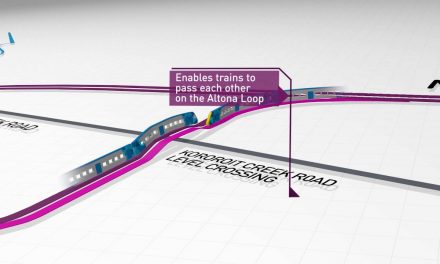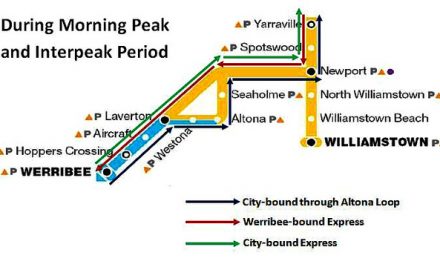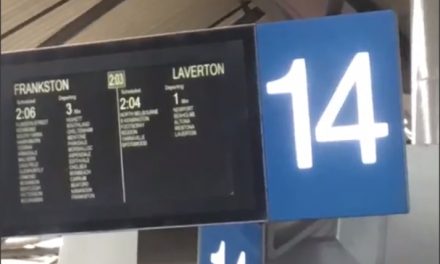I was at Laverton train station on numerous occasions, either intentionally or by accident. My home station is Westona, which is one station east of Laverton. Whenever the city-bound train was cancelled, I would take a train from Westona to Laverton and may be lucky enough to catch an express train from Laverton. This will be much faster than waiting for the next available train to arrive at Westona. I had also on several occasions boarded the wrong Werribee train that run express from Newport to Laverton. Sometimes it was the “correct train” that decided to skip the Altona Loop.
I am always amazed by the monumental carpark at Laverton station and the time it will take to walk from one end of the carpark to the other. Laverton is a very busy station, serving not only the residents of the neighbouring suburbs of Laverton, Altona Meadows, Seabrook and Point Cook but also has catchment that extends as far as Williams Landing, Truganina, Hoppers Crossing and Werribee. There are good reasons why Laverton is so popular. Aircraft station, which is just one station further from Laverton and very close to Laverton, receives far less patronage. It is in fact underutilized. One would find this phenomenon to be very strange as cars coming from Point Cook Road via the overhead bridge across Princes Freeway/M1 will reach Aircraft first. Why do people desert the closer Aircraft station for the more distant Laverton station? This is because Laverton is the last Zone 1 station on the Werribee line. Since people need to drive anyway for a considerable distance to reach a train station, they reckon they may as well drive a bit further to take advantage of a lower train fare.
After the Altona area, the train track stops running through the population centre of the residential areas, with the train stations mostly located near the periphery. For example in Hoppers Crossing, all the houses are located north of the train line and station. Only a small proportion of houses are within walking distance of Hoppers Crossing station, requiring driving to the station for the majority of commuters. You may wonder why did the residences develop so asymmetrically and not around the train station, which will be a better urban design. One possible reason is that the Princes Freeway/Highway was built very near and parallel to the train track. This had taken away land close to the train track that could be used for residential development. This resulted in housing concentrated on one side of the rail and M1 forming a physical barrier between the train station and houses located south of M1.
The Hobsons Bay Leader reported that based on Metro’s latest estimate, about 4500 people use Laverton daily but there are only 580 carpark spaces available, which get filled up by 7.30 am, forcing latecomers to park up to 1.5 km away, often illegally or unsafely (Ref 1). Parking has worsened in recent weeks and this has prompted a resident to advertise parking for rent on his property (Ref 2). How could the shortage of parking spaces at Laverton be addressed and what would the opening of the new Williams Landing station in 2013 entail?
The most obvious solution is to tackle the root of the problem – Laverton being the last Zone 1 station on the Werribee line. The Hobsons Bay City Council had requested for Zone 1 to be extended beyond Laverton but this was rejected by the State Government (Ref 1). Allowing this arrangement will firstly cut the revenues of Metro and secondly will set a precedent for other parts of Melbourne’s train network. The second option is to remove Laverton’s status as a Zone 1 station. In this scenario, the limited number of car park spaces at Altona Loop stations will prevent the migration of commuters from Laverton to the Altona Loop. However, this option is highly unlikely as this will infuriate the commuters and incur too much political risk. The most probable option is to build more and more parking spaces at Laverton. However, this option too carries a risk.
The new Williams Landing station puts yet an unknown factor into the equation. We know that commuters are deserting the nearer Aircraft station in favour of Laverton. Will the same situation happen to Williams Landing, making it a white elephant? Will the new station be used by only those residing within walking distance? After all, driving makes the distance appears shorter. If you need to drive a considerable distance anyway, will you be tempted to drive a bit further? Building more car park spaces at Laverton will have the effect of encouraging more people to use it as people do not need to worry that they will be turned away by lack of parking spaces.
There are worries that the under-utilized Aircraft station will be closed when the Williams Landing station, which is only 1 km away, is opened. The 37 traders along Aviation Road in particular fear that their business will be affected or wind up if Aircraft is shut. Terry Mulder had made an election promise to keep Aircraft open while in opposition as the spokesman on transport (Ref 3). Hence, unless he breaks his promise, we will continue to see Aircraft in operation while under the Liberal government.
Both Laverton and the new Williams Landing station do not have ramp access but Aircraft station has one. When the lifts break down at Laverton, passengers who cannot climb the steep stairs are told to catch the next train to Aircraft, where Metro provides a free taxi back to Laverton (Ref 3). This arrangement is going to change if Aircraft is closed down. The next closest train station to Laverton with ramp access will then be Westona. Apart from accessibility issues, it is also unusual that Laverton station is not served by a nearby shopping strip, despite its high human traffic. Many commuters will definitely appreciate the conveniences of having a warm morning coffee before rushing to work, a takeaway meal or doing some grocery shopping on the way back home.
There is actually another way to solve the parking shortage problem at Laverton or at any terminal Zone 1 train station. However, this solution that I will be describing will be highly unlikely in the near future for it requires a complete overhaul of the current fare structure. Melbourne is divided into Zone 1 and 2 areas, where Zone 2 areas are further away from the CBD so the commuters pay a higher public transport fare to get to the CBD. This is not a very equitable system as inevitably some passengers are subsidizing the commuting costs of others. Commuters using the last Zone 1 train station and the first Zone 2 station pay vastly different fares though the two stations may be located not far from each other. A fairer system will be to pay the fares according to the commuting distance. In other words, do away with Zone 1 and 2 and make fares distance-dependent. Under this new system, commuters will only pay slightly more if they go to Aircraft rather than Laverton. The change means that it will not be possible to have fixed-value two-hour, daily, weekly, monthly or yearly tickets. Commuters can no longer travel an unlimited number of times on a single ticket within its duration. As the train operator will be charging per trip rather than per ticket, it will be unfair to charge the current rate, which would have factored in multiple trips per ticket. For the majority of commuters who use public transport twice a day (to and from work), their fares will be reduced. This will change the way people travel, such as promoting more local trips and reducing unnecessary multiple and long-distance trips. This system represents a major change and thus a great challenge as it not only involves a change of travel mentality but also large-scale infrastructure investments such as the installation of fast and reliable ticket gantries and validators at all stations. The benefits will however be huge. There will be systemic elimination of fare evasion, which removes the need for ticket inspectors and assures the reliability of fare collection.
I had observed the following phenomenon in Singapore. Walk paths were created over lawns by pedestrians who habitually used these paths as shortcuts rather than the longer cemented walkways. So what did the government do? Instead of erecting barriers, the government chose to cement these paths. It is far more efficient and effective to go along with human natural behaviours and tendencies than to impose some artificial control measures. Obviously, the parking problem at Laverton arises as a result of a fundamental flaw in the ticketing system as no people will choose to travel further away to catch a train. The most effective way to deal with this problem is to tackle this flaw. Building more parking spaces is treating the symptoms and not the underlying cause, akin to a painkiller relieving the pains but not eradicating the disease.
Have your say and cast your vote in the following poll:





I wish more people in this country think like us…..well done my exact sentiments. Perhaps you should write about Sayers Road (were Westbourne and the Islamic schools are)and it's feral aesthetics. It has been in that state for oer a year won't be surprised if two years.
There is also another problem on Sayers, there is no concrete slab for people to stand on when raining so they get mud on their shoes while waiting for the bus, which turns up every 40mins….at least there is a bus…only after 10 years in the waiting. Ironically, Tarneit and other new areas were getting buses before this area.
A well considered article offering a sensible solution similar to the current ticketing system used in Sydney.
The only other point to consider (perhaps) is that people who live furthest from the city will pay the most for their travel into the city – unfortunately they may also be more likely to be socially disadvantaged and/or on lower incomes than those who can afford to live in inner city suburbs and pay less for public transport.